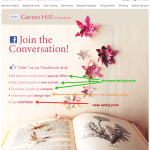A guide to this series:
Part 1 covers planning and budgeting – campaign goals and budget, campaign timeline, list selection
Parts 2 & 3 cover development of the direct mail piece – the offer, form factor, headline, and price plus persuasive copy and design.
Part 4 covers follow-on marketing and evaluation of campaign results.
1) Use a seed list
A seed list is simply a list of addresses that you add to your mailing. Your seed list should include you and your marketing team, plus, if practical, addresses for a few selected individuals scattered around the region you’re mailing into.
First, it’s a great way to keep your sales and customer-facing employees in the loop.
Second, you’ll know when your direct mail piece starts showing up in mailboxes.
And you’ll also find out if you had other unforeseen issues – for example, smudged ink or a pattern of damage because your mailing was too lightweight.
Then, feed the information you gather about timing and any mailer problems into your next direct mail project.
2) Track results
When people contact your wellness business, you need to know if they’re responding to your direct mail campaign or to something else like word-of-mouth or your newsletter, for example.
Three typical ways to do this:
If the call to action points people to your website, create a special page just for your direct mail responses. Use your website analytics to track traffic to this page.
Tell recipients to bring in their mailer to receive the special offer, extras or bonuses.
Use a unique code on the mailer that you request when potential customers call your wellness business.
3) One is not done
The follow-up plan lays out the actions your wellness business will take after the mailing is sent.
Successful direct mail is a campaign – not a one-time event. Marketing research consistently finds that your wellness business has to ping potential customers around 4 – 6 times before they actually do anything.
Think about it this way:
Your initial ping sparks curiosity. The second contact reminds them that they were curious. The ping creates awareness – they start to remember your business name. The fourth ping starts to drive action.
4) Budget vs reach vs frequency
Can’t afford to reach out more than once? Narrow your audience so that you can afford to mail more than once. Generally, it’s better to mail 1000 people four times than to mail 4000 people once.
5) Trust – but verify
Breakdowns in the fulfillment process are one of the most common problems we see.
Remember the call to action we discussed in Part 2?
Well, when your customer takes the suggested action, “fulfillment” is what your wellness business does to respond.
Document every step of your fulfillment process – and TEST IT.
For example, if your postcard said “Call for free consultation”, “fulfillment” is what happens when they call:
Do they reach someone live? Is it someone who can actually go ahead and set up the appointment? If calls go to voicemail sometimes, does the announcement make it clear that they’ve reached the right place? Does the announcement tell them when to expect a callback? And have you verified with mystery shoppers that your staff actually does callbacks in that time frame? Do you call back the day before the appointment to reconfirm? If they call to cancel, do you have a protocol for making sure they reschedule?
And so on.
Don’t assume this process actually works. Line up several people and have them call as “mystery shoppers” to test your process.
6) Follow up with everyone
You need to follow up with people who actually respond.
But you also need to follow up with people who DIDN’T respond.
Keep folks in the “didn’t respond” category on your mailing list – at least for the duration of your campaign. Remember, one ping’s not enough. Multiple contacts maximize lead generation. Mail folks again, even though they didn’t respond to the first mailing.
Is it OK to drop them after four mailings or so? Probably so.
7) Mix and match follow-up techniques
Let’s say you sent a postcard inviting employers to download a free corporate wellness report. Eighty employers downloaded the report, providing their contact info when they did so.
You then sent an email inviting them to a webinar. Only four recipients enrolled.
If you have their phone numbers, you might consider a no-pressure telephone invitation to the webinar. Or, you might invite them to a different event, like an executive briefing or panel discussion.
Or, if your initial call to action involved email or your website, switch to a postcard for your next follow-up.
8) Sequence your follow-up marketing
Let’s say your initial call to action was a postcard with an invitation to a free healthy snacking seminar. Your hope is that people who attend this seminar will enroll in your healthy family lifestyles program.
Remember that your snacking seminar is a marketing event – not just an instructional event.
That means you need ANOTHER call to action – to get people to sign up for the lifestyles program – supported by its own sales and marketing materials. In other words, you need two marketing “packages” – one for the postcard and snacking seminar, a second one for the healthy lifestyles program.
For example, perhaps your call to action at the seminar is to “sign up by May 31 for our healthy lifestyles program and save $149”.
You’ll want to bake that message into the presentation, create leave-behinds with the special offer at the tables where participants sit, on easels and flyers next to the refreshments table, in personal notes and emails that you send after the seminar, in the restrooms, in phone calls you make afterwards, and so on.



